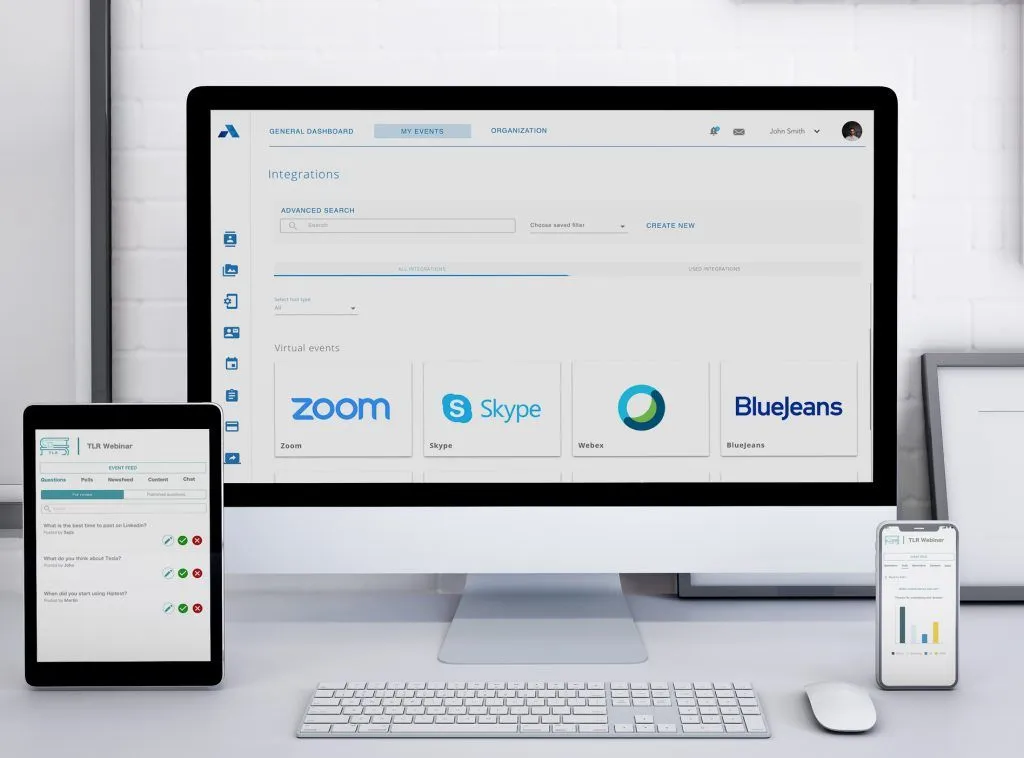Restructuring the Experience: From Physical to Virtual Events
In this blog, we discuss the increasing demand for virtual events as conferences and trade shows shift to online formats. From live streaming to pre-recorded sessions, these events offer cost-effective, engaging ways to connect attendees while reducing carbon footprints. Learn the essential steps to create your own immersive virtual experience.

It’s no surprise to see more and more industry conferences and trade shows being canceled, postponed or switched into virtual events. This has forced people to change their plans and travel itineraries for the upcoming months and look for online alternatives to this sudden change. Now, instead of being on a crowded expo floor, attendees are watching webinar sessions, live-stream events or pre-recorded content straight from their homes or offices.
Even though onsite events provide unique advantages such as face-to-face interactions, the demand for virtual events continues to increase, especially now. From live-streaming to pre-recorded sessions, more companies are restructuring their events to offer engagement-driving experiences that extend beyond a computer screen. This has opened the door to new ways to connect people online while reducing costs and carbon footprints.
Many event planners that have already shifted to online events and virtual meetups are still in the “figuring it out” stage. Why is that? Well, some didn’t have these types of events as their core strategy and others are probably doing this for the first time. But the truth is that no one knows what’s the best formula for every event. What we do know is that there’s a lot more to a virtual event than just hosting a webinar, that’s why it’s important to have a clear structure to follow when planning a virtual event.
Whether you have an event programmed for this year or you’re just looking for ideas to get digital, use this structure to plan your own immersive online experience.
Approach and Platforms
Before deciding on the best approach to host a virtual event, you have to go through your event brief to see if the plan translates well into a virtual format. Just because everyone else is doing it, doesn’t mean you should too. If a virtual experience serves the purpose of your event goals and objectives, then it makes sense to go digital. If it doesn’t align, you’ll have to find an approach that will work best.
Once you have this clear, consider the following questions: Why will attendees sign-up for your event? What do you offer that will add value? Based on the answers you’ll be able to decide which type of content is right for your event. Make sure to prioritize the key content and takeaways.
Now, it’s time to evaluate which type of virtual event suits best with your established goals and objectives:
- Fully Virtual
Virtual events involve people interacting in a virtual environment rather than a physical location. These online events are multi-session, highly interactive and can feature webinars and webcasts. Plus, they’re suitable for any event that features multiple presentations, discussion rooms or brand experiences to engage your participants.
- Hybrid
A hybrid event is every format – conference, trade expo, training seminar, etc. – that combines live elements, like interviews or presenters with virtual components. It offers an effective way to increase participation and reach, while utilizing live-elements for an in-person feel.
- Live-Streaming
Live streaming events are great to expand your company’s reach, improve its visibility and distribute the content available to a new audience. This type of online event allows attendees to easily share the event with other people, such as coworkers, friends or family. It also can be incredibly cost-effective for event planners.
- Pre-recorded
This type of online event is captured, edited and shared for viewing later. Not only can it be premiered on a specific date but it also can be available online via video on demand (VOD). At the same time, it gives the possibility to make the content appear live, even if it’s not. This option offers more flexibility to event planners.
Program Format and Design
Just like onsite conferences, virtual events come in many program formats. Whether you decide to have a panel discussion, a series of interviews, or pitch rounds, you have to offer a unique experience for your attendees, something that will make your company differentiate from the competition.
- Panel Discussions:
- They bring together top talent experts in different areas to share and build upon each other’s experience.
- They are useful if a topic is too complex for one person to handle, or if the audience needs to be exposed to various viewpoints at the same session.
- Interviews:
- Are deep-dive dialogues between event hosts and subject matter experts.
- Experts can share their knowledge in live Q&A sessions, which helps keep things engaged with the audience.
- Pitch rounds:
- Pitch Rounds are held with the sole purpose of allowing startups to pitch their ideas to a group of juries (usually investors or stakeholders).
- This virtual format is a great way to increase the retention of attendees because of its dynamic.
Keynotes:
- Keynotes inspire, entertain and educate audiences on a specific subject matter.
- The keynotes are conducted by speakers chosen for their expertise in a particular area and their ability to draw an audience.
- In a virtual environment, speakers no longer need to travel to another place to give their keynote, and attendees no longer have to look for available seats to attend the session!
Going online also means bringing your company’s design and branding into a digital space. Make sure to consult your brand guidelines before creating any visual material, or building any prop or set for your event. Similarly, all the physical and/or digital design created for the event must maintain the consistency of your graphic identity.
Technology

Event planners successfully host virtual events when they have the proper set of technological tools available. To prepare for the big day, you have to think about these questions: Where the event will be filmed? Will it be all remote? or in a studio? or in an office? Based on your answers, you can identify the setup that you’re going to need, such as audio and visual gear, home equipment, studio equipment, etc.
Besides these technological elements, event planners can also benefit from the use of an event technology platform to plan their entire event process, from the promotion to the execution and the management. Here are the most important event tech solutions to use when executing a virtual event:
- Event Website
An event website is the forefront of any in-person or virtual event and works as a powerful tool for attracting new attendees. Through your event website, you can seamlessly promote your event by providing rich content that keeps potential attendees informed and entices them to register for the event. Your event website should also communicate the value of your virtual event while having the same look and feel of your company.
- Registration
A robust registration tool allows you to effortlessly set up registration forms for participants, speakers, sponsors, and approvals, in one single place. These forms will allow people to register for the virtual event, submit their preferences and provide payment information without any trouble. You can ensure that you’ll deliver a flawless registration experience while increasing event attendance.
- Email Marketing
helps you expand your brand awareness by targeting and connecting with the right participants, at the right time. Not only you can drive demand for your virtual event, but also you can increase registrations and keep attendees informed. Use an email marketing tool that allows you to brand and personalize your emails, as well as to automate and schedule based on attendee data – all while tracking open rates, click-through rates, and conversion rates.
- Event App
An Event App is one of the most crucial pieces of event technology for virtual events. This tool helps increase the involvement of the participants through features that stimulate interaction before, during and after the event. For attendees, this is where they can choose which sessions they want to add to their agenda, have a good overview of the active topics and participate via polls and questions during the sessions. For planners, this is where they gather relevant data, such as attendee engagement and session popularity.
Online Host(s)
On-Camera – Depending on the type of virtual event, you have to find speakers and/or experts that will give talks on specific topics, do interviews or participate in panel discussions during your event. They should be thought leaders with a strong following. Also, have in mind that not all speakers that have stage confidence have screen confidence. Don’t invite someone who won’t be comfortable in this type of event format.
Off-camera – To ensure that comments and interactions of attendees are being addressed, you have to assign that task to someone from your team. You’ll see how the audience will feel included and noticed during the sessions – this helps increase the participation over chat and social, hence the retention.
Interactivity and Engagement

When hosting a virtual event, you can’t simply live stream your planned session and expect that this will be the best online experience for your attendees. You have to consider interactivity and engagement in every content-making decision of your virtual event. These aspects can make the difference when viewers decide to tune in life or to remain in the virtual event.
If you allow attendees to be part of a real-time conversation, their event experience will be more exciting and engaging! Have in mind that in a virtual environment, you can include fireside chats, interactive elements, and real-time examples that wouldn’t necessarily fit into an offline, traditional stage setting.
Integrate these tactics to increase your event interactivity and engagement:
Q&As – During your virtual event, select the best questions from your audience or let them decide which ones they’d like to discuss.
Live Polls – Increase the interaction of your virtual meeting and events by polling your audience in real time.
Gamification– Generate high-quality experiences and increase attendees’s participation and engagement in the sessions by using gamification.
Chat functionality– Enable attendees to interact and engage in real-time with each other with a chat functionality.
Now that you have the ideal structure to develop virtual events, you can determine whether or not you should start planning your own immersive online experience. Remember, with the right plan and the proper technology, you can deliver an outstanding experience to your attendees!
Azavista provides a powerful tool stack that helps you successfully plan any event, whether it is an in-person or virtual event. Our solid integrations ensure a digital-first event preparation for your virtual events. With our building blocks, you easily build your conference outline. Our plug-and-play meeting templates maximize the participant experience whilst saving you precious time for seizing new opportunities.











